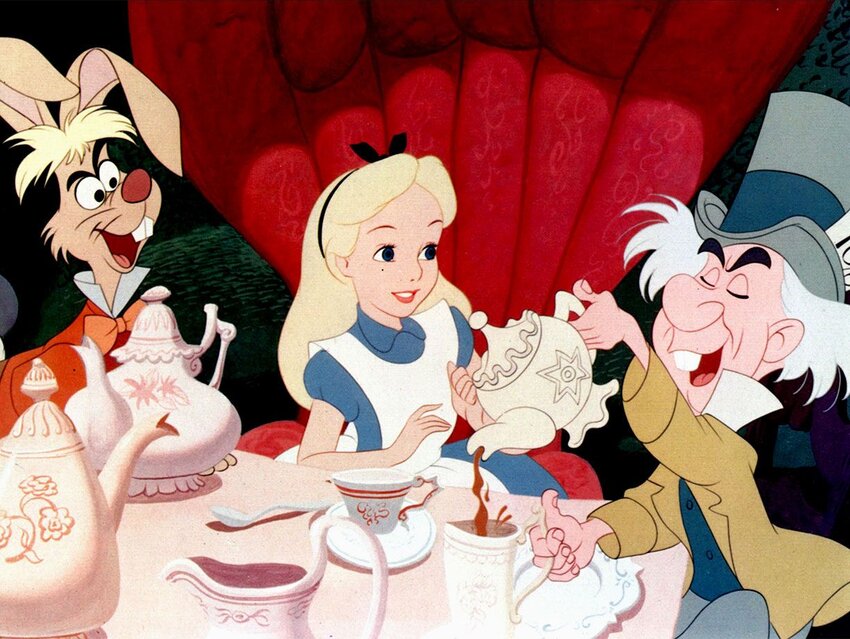In the mid-1800s, a British teenager named Charles Dodgson honed and harnessed his love for wordplay to produce a series of whimsical magazines for his family. Since he was on track for a career in mathematics, his creations were considered little more than passing amusements. However, those flights of fancy would provide fuel for Dodgson as he later regaled the children of his friend (and dean of Oxford University’s Christ Church) Henry Liddell with astonishing tales during family picnics.
One of the children, Alice, asked him to write down the stories, which he eventually published under the pen name Lewis Carroll. Alice’s Adventures in Wonderland (1865), along with its sequel Through the Looking Glass (1871), not only delighted readers and inspired countless film, TV, theater, and other pop culture products, but also added fantastical words and phrases to the English lexicon that are still widely used over 150 years later.
Down the Rabbit Hole
The adventures in language begin when the character Alice chases a time-obsessed bunny underground, giving English the illustrative idiom “down the rabbit hole.” The Wachowskis famously borrowed this for the beginning of the first Matrix film, when Morpheus offers Mr. Anderson/Neo the chance to return to normal or “stay in Wonderland and I show how far down the rabbit hole goes.”
In the age of hyperlink-rich internet pages, the metaphor has taken on a new meaning. One might feel like Alice, slowly tumbling toward Wonderland, after hours spent clicking on Wikipedia entry after YouTube video after Reddit thread, falling down the rabbit hole of a specific topic.
Some other phrases are inextricably linked to the Alice books but actually appeared before Carroll’s works. “Mad as a hatter,” for example, was in use well before Alice stumbled upon the Mad Hatter’s bizarre tea party. Some attribute the simile to the effects of mercury poisoning sometimes suffered by hatmakers — mercury was used to soften furs being turned into felt — but Carroll himself said, “I’m very much afraid I didn’t mean anything but nonsense! Still, you know, words mean more than we mean to express when we use them.”
Novelist William Makepeace Thackery (of Vanity Fair fame) described a character who “...grins like a Cheshire cat” a decade before Carroll’s famed disappearing/reappearing feline. Even the names of the rotund pair Tweedledee and Tweedledum were terms first used in the 18th century to describe the sounds of high and low instruments, before being used to describe interchangeable people or situations in the 19th century. While he didn’t create these expressions himself, Carroll made them interesting enough to be relevant a century and a half later.
Jabberwock With Me
Carroll’s follow-up, Through the Looking Glass, was responsible for many additions to the dictionary, thanks to a poem Alice finds. Jabberwocky is a classic boy-meets-monster/boy-slays-monster story told thousands of times before, but what happens in the story isn’t as important as how the story is told.
The Jabberwock itself is “a fantastical dreaded monster with flaming eyes,” but the word “jabberwocky” was added to the OED in 1908 as “nonsensical speech or writing.”
Upon first glance, Alice can’t read the backward-printed text of the poem. That changes with the aid of a mirror, but the work still contains words she has never seen before. Indeed, these were words no one had seen before, the product of Carroll’s fertile imagination. They included “slithy” (slimy/lithe), “frabjous” (great, wonderful, fabulous), and “mimsy” (miserable/flimsy) — all strings of letters with a faint semblance to preexisting words. These “nonce words,” created to serve one purpose, must be guessed at by the reader (with a little in-book help from Humpty Dumpty).
While not every made-up word caught on (few people still refer to their foes as “manxome”), the dictionary did get a little thicker thanks to Alice’s author. If you’ve ever galumphed, Lewis Carroll is responsible. He created the word to describe the Jabberwock vanquisher’s victorious motion while holding the beast’s severed head.
Whereas today the word “galumph” indicates a clumsy and noisy movement, originally it was a blending of “gallop” and “triumphant.” This celebratory gesture was paired with an appropriate sound — Carroll combined “chuckle” and “snort” to create “chortle,” a word so popular it was included in a dictionary by 1902. Even the weapon, the vorpal blade, has found its way into Dungeons and Dragons manuals as a sword “capable of decapitation, specifically through magical means.”
So powerful was Carroll’s ability to blend words into unique letter smoothies that the analogy he used to describe his new words is still used today. When Alice has trouble deciphering the fantastical poem, she’s told the unfamiliar words have two meanings packed into one term, like a portmanteau. Readers of the time would have known a portmanteau as a piece of luggage that opened into two equal parts. While the luggage may be found at an antique store, words such as “spork,” “Brexit,” and “turducken” prove literary portmanteaus are still alive and galumphing.
Featured image credit: Allstar Picture Library Limited./ Alamy Stock Photo

